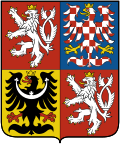- Constitution of the Czech Republic
-
Czech Republic 
This article is part of the series:
Politics and government of
the Czech RepublicConstitutionGovernmentPolitical partiesAdministrative divisions
The current Constitution of the Czech Republic (Czech: Ústava České republiky) was adopted on December 16, 1992. It replaced the constitution of Czechoslovakia (1960 Constitution of Czechoslovakia), which split into the Slovak Republic and the Czech Republic by act of parliament on January 1, 1993, through the so-called Velvet Divorce.
The document is organized into eight chapters. Each, save the last, is concerned with a distinct aspect of government. The final chapter deals with a number of "interim" topics, which were largely resolved by 31 December 1993, and currently have little bearing upon the governance of the Republic.
As of 2011[update], the constitution has been amended five times.
Contents
Chapter One
The first few articles of the constitution give basic form to the nature of the government of the Republic. It binds the government to a "respect for the rights and freedoms of man and citizen"; proclaims the Charter of Fundamental Rights and Basic Freedoms an "integral component of the constitutional system"; establishes the republic as a democratic, law-abiding state, deriving its sovereignty from the people; says that "majority decisions shall respect protection of minorities"; and enjoins the Republic "to a prudent utilization of natural resources and to protection of natural wealth". In this early part of the document, the constitution also allows for its amendment by a Constitutional Act, but forbids amending the constitution in any way that will compromise the Republic's standing as a "democratic, law-abiding state". Chapter One gives an outline of the Republic's duties towards international law, saying (in part) that conflicts between domestic laws and international laws binding upon the Republic must be resolved in favor of international agreements. The opening chapter concludes by defining the capital, national symbols, territory and rules of citizenship for the Republic (Articles 1–14).
Chapter Two
It vests legislative power in the Czech Parliament, consisting of two chambers, the Chamber of Deputies and the Senate (Articles 15–53).
Chapter Three
It provides for the ways in which specific executive powers shall be delineated between the President of the Republic and the government (as headed by the Prime Minister). The chapter also outlines the nature of the indirect election of the President by the Parliament, as well as the limitations of presidential power in selecting a government. This section also includes a number of historically significant regulations with respect to the Czech Republic's accession to the European Union (Articles 54–80).
Chapter Four
The Constitution establishes the Constitutional and Supreme Courts, as well as the independence of the judiciary (Articles 81–96).
Chapter Five
The constitution establishes The Supreme Control Office (Article 97).
Chapter Six
The constitution establishes the Czech National Bank (Article 98).
Chapter Seven
The constitution provides the basis for local government, by dividing the territory of the republic into self-governing territorial districts, and regions (Articles 99-105).
Chapter Eight
The document concludes by weighing in on a number of so-called "interim" issues which mainly applied to the Republic in its first year of existence. Chiefly, it specifically delineates what officers or laws of the former Czech government as a constituent part of the Czechoslovak Federal Republic remained in force until the Czech Republic produced new officeholders or laws under the provisions found elsewhere in the constitution. Of the provisions of this chapter, by far the most lasting has been Article 112 (1), which made the Charter of Fundamental Rights and Freedoms (1991) a part of the constitution. This move has commonality with the way in which the Bill of Rights was quickly annexed to the US constitution, granting Czech citizens specific personal rights that would be extremely difficult for a future Czech government to abrogate (Articles 106–113).
See also
- Constitutional development of Czechoslovakia
- Constitution
- Constitutional law
- Constitutional economics
- Constitutionalism
External links
- (English) Constitution of the Czech Republic
- (Czech) Ústava České republiky
- (English) Charter of Fundamental Rights and Freedoms
- (Czech) Listina základních práv a svobod
 Czech Republic
Czech RepublicHistory Geography RiversGovernance Politics Economy Society Culture Symbols Flag · Coat of arms
 Category ·
Category ·  Portal ·
Portal ·  WikiProject
WikiProjectConstitutions of Europe Sovereign
states- Albania
- Andorra
- Armenia
- Austria
- Azerbaijan
- Belarus
- Belgium
- Bosnia and Herzegovina
- Bulgaria
- Croatia
- Cyprus
- Czech Republic
- Denmark
- Estonia
- Finland
- France
- Georgia
- Germany
- Greece
- Hungary
- Iceland
- Ireland
- Italy
- Kazakhstan
- Latvia
- Liechtenstein
- Lithuania
- Luxembourg
- Macedonia
- Malta
- Moldova
- Monaco
- Montenegro
- Netherlands
- Norway
- Poland
- Portugal
- Romania
- Russia
- San Marino
- Serbia
- Slovakia
- Slovenia
- Spain
- Sweden
- Switzerland
- Turkey
- Ukraine
- United Kingdom
- Vatican City
States with limited
recognition- Abkhazia
- Kosovo
- Nagorno-Karabakh
- Northern Cyprus
- South Ossetia
- Transnistria
Dependencies
and other territoriesOther entities - European Union
- Sovereign Military Order of Malta
Categories:- Government of the Czech Republic
- 1992 in law
- Constitution of the Czech Republic
Wikimedia Foundation. 2010.
